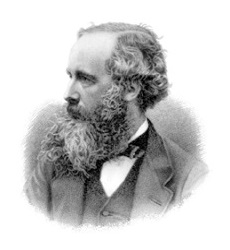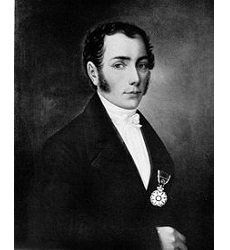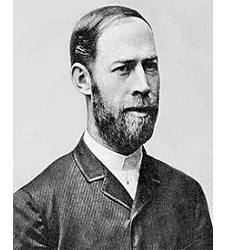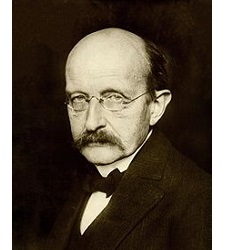
جیمز کلرک ماکسول
(۱۳ ژوئن ۱۸۳۱ – ۵ نوامبر ۱۸۷۹)
فیزیکدان و ریاضیدان اسکاتلندی • پدر الکترومغناطیس کلاسیک
جیمز کلرک ماکسول، این نابغه اسکاتلندی، بدون شک یکی از تأثیرگذارترین دانشمندان در تاریخ علم محسوب میشود. کارهای او پایههای جهان مدرن را بنا نهاد. ماکسول در یک خانواده ثروتمند به دنیا آمد و از کودکی نبوغ خود را نشان داد. در ۱۴ سالگی اولین مقاله علمی خود را درباره رسم منحنیهای بیضوی نوشت.
دستاوردهای برجسته:
- تدوین معادلات ماکسول - چهار معادله دیفرانسیلی که رفتار میدانهای الکتریکی و مغناطیسی را توصیف میکنند
- پیشبینی وجود امواج الکترومغناطیسی و محاسبه سرعت آنها که برابر با سرعت نور بود
- توسعه نظریه جنبشی گازها و توزیع ماکسول-بولتزمن
- ایجاد اولین عکس رنگی پایدار در جهان در سال ۱۸۶۱
- پایهگذاری مکانیک آماری مدرن
— آلبرت انیشتین
نظریه الکترومغناطیس ماکسول نه تنها الکتریسیته، مغناطیس و نور را متحد کرد، بلکه راه را برای توسعه نسبیت خاص انیشتین هموار ساخت. انیشتین تصویر ماکسول را در اتاق کار خود نگه داشته بود و او را در کنار ایزاک نیوتن قرار میداد.

متأسفانه ماکسول در ۴۸ سالگی بر اثر سرطان معده درگذشت، در حالی که بسیاری از همعصرانش هنوز عمق و اهمیت کارهای او را درک نکرده بودند. امروزه از او به عنوان دانشمندی یاد میشود که تأثیر او بر تمدن بشری با نیوتن و انیشتین برابری میکند.

آلبرت انیشتین
(۱۴ مارس ۱۸۷۹ – ۱۸ آوریل ۱۹۵۵)
فیزیکدان نظری آلمانی • پدر فیزیک مدرن
آلبرت انیشتین، این نماد نبوغ علمی، جهانبینی ما را درباره فضا، زمان و گرانش برای همیشه تغییر داد. جالب است بدانید که انیشتین در کودکی دیرآموز بود و تا سه سالگی حرف نمیزد! او در مدرسه عملکرد ضعیفی داشت و در امتحان ورودی دانشگاه پلیتکنیک زوریخ رد شد.
انقلابی در فیزیک:
- نظریه نسبیت خاص (۱۹۰۵) - E=mc² و اتساع زمان
- نظریه نسبیت عام (۱۹۱۵) - توصیف جدید از گرانش
- تفسیر پدیده فوتوالکتریک و معرفی مفهوم فوتون
- پیشبینی عدسیهای گرانشی
- پیشبینی امواج گرانشی (که یک قرن بعد تأیید شد)
- مبارزه برای صلح جهانی و مخالفت با تسلیحات هستهای
— آلبرت انیشتین
سال ۱۹۰۵ به عنوان "سال معجزه" انیشتین شناخته میشود، زمانی که او در ۲۶ سالگی و در حالی که کارمند درجه سه اداره ثبت اختراعات بود، چهار مقاله انقلابی منتشر کرد که هر کدام به تنهایی برای کسب جایزه نوبل کافی بود.
انیشتین نه تنها یک دانشمند بزرگ، بلکه یک انسانگرای عمیق بود که علیه نژادپرستی و برای صلح جهانی مبارزه کرد. او در سال ۱۹۵۵ درگذشت و مغز او برای تحقیقات علمی حفظ شد.

یوزف فون فرانهوفر
(۶ مارس ۱۷۸۷ – ۷ ژوئن ۱۸۲۶)
فیزیکدان و سازنده ابزارهای نوری آلمانی • بنیانگذار طیفبینی
داستان زندگی فرانهوفر از یک تراژدی شروع شد. در ۱۴ سالگی، کارگاه شیشهسازی که در آن کارآموزی میکرد فرو ریخت و او به طرز معجزهآسایی نجات یافت. این حادثه توجه ماکسیمیلیان چهارم، پادشاه باواریا را جلب کرد و او کمک هزینه آموزشی برای فرانهوفر فراهم کرد.
ابداعات و کشفیات:
- کشف خطوط تاریک در طیف خورشید (خطوط فرانهوفر)
- اختراع اسپکتروسکوپ پیشرفته
- توسعه توری پراش با دقت بالا
- ساخت بهترین تلسکوپهای شکستی زمان خود
- ابداع روشهای جدید برای تولید شیشه نوری با کیفیت
- پایهگذاری طیفبینی نجومی
خطوط فرانهوفر که او در طیف خورشید کشف کرد، بعدها کلید فهم ترکیب شیمیایی ستارگان شد. هر عنصر شیمیایی الگوی خاصی از این خطوط را ایجاد میکند که مانند اثر انگشت آن عنصر عمل میکند.
متأسفانه فرانهوفر در ۳۹ سالگی بر اثر بیماری سل درگذشت. میراث او در انجمن فرانهوفر که بزرگترین سازمان تحقیقاتی کاربردی در اروپا است، زنده مانده است. این سازمان در زمینههای مختلف از فوتونیک تا زیستفناوری فعالیت میکند.

هاینریش رودولف هرتز
(۲۲ فوریه ۱۸۵۷ – ۱ ژانویه ۱۸۹۴)
فیزیکدان تجربی آلمانی • اثباتکننده وجود امواج الکترومغناطیسی
هاینریش هرتز با آزمایشهای ظریف و دقیق خود، پیشبینیهای تئوری ماکسول را به اثبات رساند و راه را برای انقلاب ارتباطات مدرن هموار کرد. او در خانوادهای فرهیخته به دنیا آمد و از کودکی استعداد فوقالعادهای در زبانهای خارجی و علوم نشان داد.
دستاوردهای آزمایشگاهی:
- اثبات تجربی وجود امواج الکترومغناطیسی (۱۸۸۸)
- اندازهگیری سرعت امواج الکترومغناطیسی و نشان دادن برابری آن با سرعت نور
- کشف پدیده فوتوالکتریک (هرچند نتوانست آن را توضیح دهد)
- اثبات اینکه امواج الکترومغناطیسی میتوانند منعکس و شکست شوند
- ساخت اولین فرستنده و گیرنده امواج رادیویی
— هاینریش هرتز (که در اشتباه بود!)
آزمایشهای هرتز بسیار ساده اما هوشمندانه بودند. او از یک جرقهزن برای تولید امواج و یک حلقه سیم با فاصله کوچک به عنوان آشکارساز استفاده کرد. وقتی امواج به حلقه میرسیدند، جرقههای کوچکی در فاصله ایجاد میشدند.
متأسفانه هرتز در ۳۶ سالگی بر اثر بیماری گرانولوماتوز وگنر درگذشت. او هرگز شاهد انقلاب ارتباطاتی که کارهایش باعث آن شد نبود. امروزه واحد فرکانس به افتخار او "هرتز" نامیده میشود.

ماکس کارل ارنست لودویگ پلانک
(۲۳ آوریل ۱۸۵۸ – ۴ اکتبر ۱۹۴۷)
فیزیکدان نظری آلمانی • پدر نظریه کوانتوم
ماکس پلانک، این فیزیکدان محافظهکار که خود را "انقلابی ناخواسته" میخواند، با معرفی مفهوم کوانتا، بنیانهای فیزیک کلاسیک را متزلزل کرد و عصر جدیدی در علم گشود. پلانک در خانوادهای فرهیخته به دنیا آمد و استعداد فوقالعادهای در موسیقی داشت.
پایهگذاری فیزیک کوانتومی:
- معرفی مفهوم کوانتومی انرژی (۱۹۰۰)
- کشف ثابت پلانک (h) - پایهای برای مکانیک کوانتومی
- استخراج قانون تابش جسم سیاه
- پیشگامی در ترمودینامیک آماری
- کمک به توسعه نظریه نسبیت
- بنیانگذاری انجمن ماکس پلانک
— ماکس پلانک
پلانک در ابتدا به دنبال توضیحی "کلاسیک" برای مسئله تابش جسم سیاه بود، اما ناچار شد این ایده انقلابی را بپذیرد که انرژی به صورت بستههای گسسته (کوانتا) منتقل میشود. این ایده آنقدر برای خودش عجیب بود که سالها سعی کرد آن را با فیزیک کلاسیک آشتی دهد.
زندگی شخصی پلانک تراژدیهای زیادی داشت: هر چهار فرزندش را از دست داد و خانهاش در جنگ جهانی دوم بمباران شد. با این حال، او تا آخر عمر به فعالیت علمی ادامه داد. امروزه انجمن ماکس پلانک با ۸۶ مؤسسه، یکی از پیشروترین سازمانهای تحقیقاتی جهان است.

هرمان لودویگ فردیناند فون هلمهولتز
(۳۱ اوت ۱۸۲۱ – ۸ سپتامبر ۱۸۹۴)
فیزیکدان و فیزیولوژیست آلمانی • دانشمند چندرشتهای
هرمان فون هلمهولتز نمونه بارز یک دانشمند رنسانسی در عصر مدرن بود که در رشتههای مختلف از فیزیک و فیزیولوژی تا روانشناسی و فلسفه دستاوردهای برجستهای داشت. او که ابتدا به عنوان جراح ارتش آموزش دید، بعدها به یکی از بزرگترین دانشمندان قرن نوزدهم تبدیل شد.
دستاوردهای چندرشتهای:
- کشف قانون پایستگی انرژی در فیزیولوژی
- اندازهگیری سرعت انتقال پیامهای عصبی
- اختراع افتالموسکوپ برای معاینه شبکیه چشم
- توسعه نظریه سهرنگی بینایی رنگ
- مطالعات پیشگامانه در آکوستیک و موسیقی
- توسعه معادله هلمهولتز در دینامیک سیالات
- پیشگامی در ترمودینامیک و الکترودینامیک
هلمهولتز در ۲۶ سالگی، در حالی که هنوز جراح ارتش بود، مقالهای منتشر کرد که در آن قانون پایستگی انرژی را در موجودات زنده اثبات کرد. این کار انقلابی در فیزیولوژی ایجاد کرد و نشان داد که قوانین فیزیکی در بدن موجودات زنده نیز حاکم هستند.
— هرمان فون هلمهولتز
هلمهولتز نه تنها یک دانشمند برجسته، بلکه معلمی الهامبخش بود. بسیاری از فیزیکدانان بزرگ بعدی مانند هاینریش هرتز و مکس پلانک از شاگردان او بودند. میراث هلمهولتز در انجمن هلمهولتز که بزرگترین سازمان علمی آلمان است، زنده مانده است.


